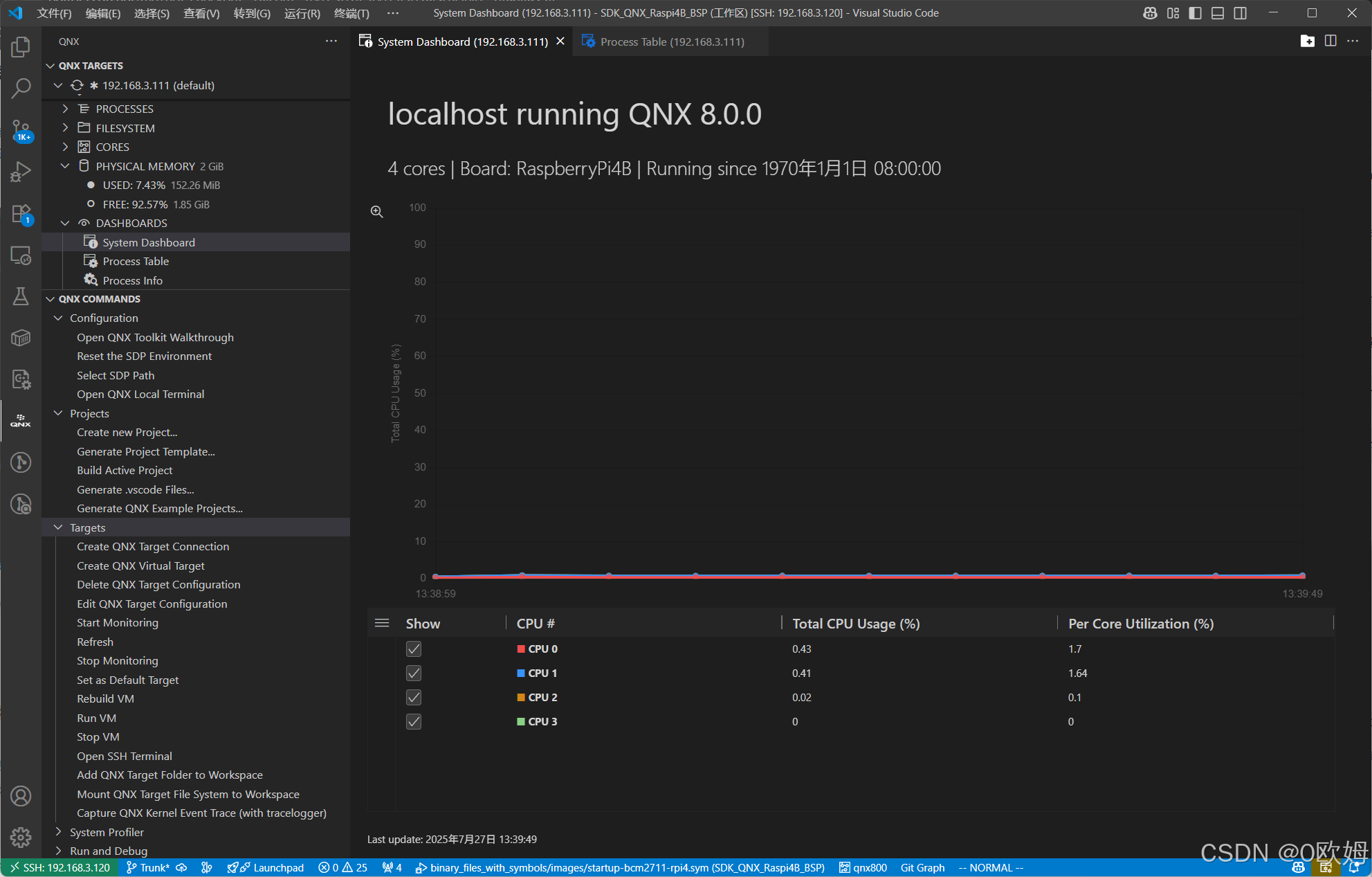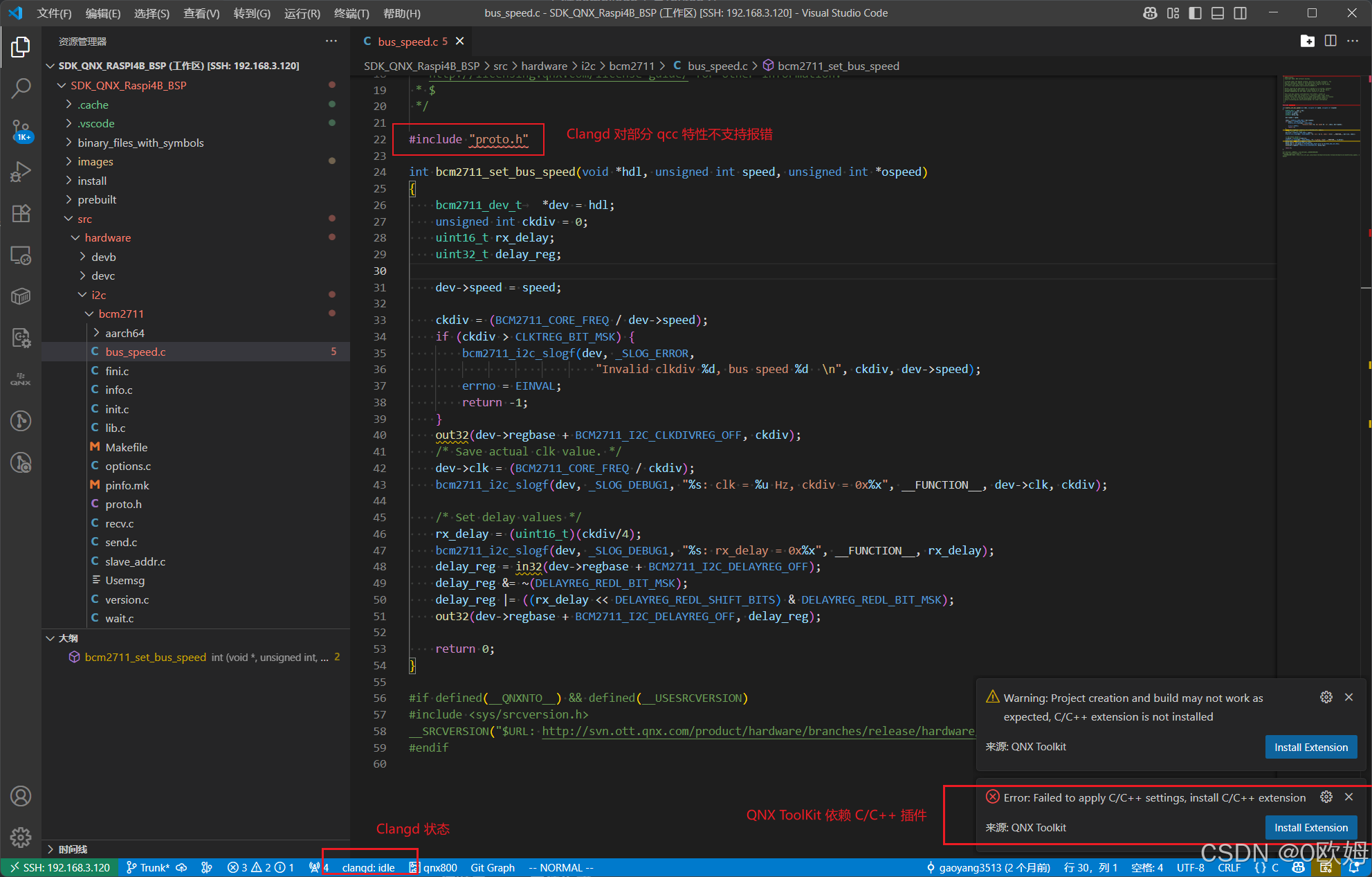编译构建
# 环境初始化
source /home/gaoyang3513/Workspaces/qnx800/qnxsdp-env.sh
# 编译
make
环境配置
要在VS Code中实现对QNX工程源码的正确跳转(Go to Definition/Declaration)、自动补全(IntelliSense)和错误检查,需要安装并配置 C/C++ 插件或Clangd插件。虽然两个插件都可以实现最终的代码跳转但过程有些差异,总结起来C/C++插件更友好和快捷,所以比较推荐。
QNX 插件
QNX官方开发的插件,集合了很多功能,比较下来比较好用的功能有: SDP环境配置、交互终端(QNX初始化)、工程管理、设备在线调整、系统监控等。

C/C++ 插件
配置C/C++插件使其获知QNX编译环境的头文件路径、宏定义以及编译器路径,主要通过编辑项目根目录下.vscode/c_cpp_properties.json 文件来完成。以下是配置步骤和示例:
前提条件
- 安装VS Code: 确保已经安装Visual Studio Code;
- 安装Remote SSH扩展:在VS Code中安装Microsoft的"Remote SSH"扩展(
ms-vscode-remote.remote-ssh)。 - 安装C/C++扩展: 在VS Code中安装Microsoft的"C/C++"扩展(
ms-vscode.cpptools)。 - 安装QNX Momentics SDK:确保已经安装了QNX Momentics SDK,获知了安装路径(例如,示例路径
~/Workspaces/qnx800)。
配置步骤
打开或创建QNX工程:在VS Code中打开你的QNX工程文件夹。
生成
c_cpp_properties.json- 按下
Ctrl+Shift+P(或Cmd+Shift+Pon macOS) 打开命令面板。 - 输入
C/C++: Edit Configurations (UI)或C/C++: Edit Configurations (JSON)。 - 选择
(JSON)选项,VS Code 会在你的项目根目录下创建一个.vscode文件夹,并在其中生成c_cpp_properties.json文件。
- 按下
编辑
c_cpp_properties.json
打开生成的c_cpp_properties.json文件,并根据你的QNX SDK版本和目标架构进行修改。{ "configurations": [ { "name": "QNX 8.0 x86_64", // 配置名称,可自定义 "compilerPath": "/home/gaoyang3513/Workspaces/qnx800/host/linux/x86_64/usr/bin/qcc", // QCC 编译器的路径 "includePath": [ "${workspaceFolder}/**", // 包含当前工作区的所有头文件 "/home/gaoyang3513/Workspaces/qnx800/target/qnx" // QNX 系统头文件路径 ], "defines": [ "__QNX__", // QNX 平台的宏定义 "_NTO_VERSION=800", // QNX Neutrino 版本宏,根据实际版本修改 "__AARCH64__", // AArch64 架构宏 "__ARM_ARCH_8A__" // ARMv8-A 架构宏 ], "intelliSenseMode": "gcc-x64", // IntelliSense 模式,因为QCC基于GCC,所以选择gcc-x64 "browse": { "path": [ "${workspaceFolder}", "/home/gaoyang3513/Workspaces/qnx800/target/qnx/usr/include" ], "limitSymbolsToIncludedHeaders": true }, "cStandard": "c11", // C语言标准 "cppStandard": "c++11" // C++语言标准 } ], "version": 4 }
效果演示

Clangd 插件(可选)
配置Clangd插件使其支持QNX源码的跳转需要依赖工程顶层目录下的compile_command.json 文件来完成。以下是配置步骤和示例:
前提条件
- 安装VS Code: 确保已经安装Visual Studio Code;
- 安装Remote SSH扩展: 在VS Code中安装Microsoft的"Remote SSH"扩展(
ms-vscode-remote.remote-ssh)。 - 安装Clangd扩展:在VS Code中安装Microsoft的"Clangd"扩展(
llvm-vs-code-extensions.vscode-clangd)。 - 安装QNX Momentics SDK:确保已经安装了QNX Momentics SDK,获知了安装路径(例如,示例路径
~/Workspaces/qnx800)。
配置步骤
打开或创建QNX工程:在VS Code中打开你的QNX工程文件夹。
生成 `c_cpp_properties.json
安装compiledb工具(pyton3)
pip3 install --user compiledb编译并生成compile_commands.json
compiledb make
编辑
c_cpp_properties.json:Clang 无能支持QCC私有的一些特性,所以需要针对性修改,包括且不限于下面的修改:
# 替换 sed -i 's/-Vgcc_ntoaarch64/-D__QNX__/' compile_commands.json # 后追加一行 sed -i '/"-D__QNX__",/a\ "-D__QNXNTO__",' compile_commands.json sed -i '/"-D__QNX__",/a\ "-D__aarch64__",' compile_commands.json sed -i '/"-EL",/a\ "-D__LITTLEENDIAN__",' compile_commands.json # 前追加一行 #sed -i '/"-D__QNX__",/i\ "-D__aarch64__",' compile_commands.json
效果演示

问题解决
问题一、C/C++ 无法工作且打不开配置
排查出原因为安装了 Clangd 扩展后把会警告和 C/C++ 扩展存在冲突,当前点击"Disable IntelliSense"后C/C++插件的配置将会消失。

进到设置,搜索关键字"intelliSenseEngineFallback",由 “disabled” 修改为 "default"即可。规避干扰,可对当前工作区禁用 Clangd 插件。
问题二、bear无法生成compile_commands.json
使用bear工具虽然可以正常编译但最终生成的compile_command.json文件为空。
$ bear -- make
...
所以需要使用替换方案 compiledb 或自行编写python脚本收集编译日志生成 compile_command.json 文件,庆幸的是QNX的编译框架恰好会将所有 qcc 编译命令显式打印出来。所以使用AI工具生成的对编译日志收集并分析出compile_command.json文件的python脚本如下:
import sys
import re
import json
import os
import shlex
from collections import defaultdict
def detect_qnx_sysroot():
"""检测QNX系统根目录"""
# 1. 尝试从环境变量获取
if 'QNX_TARGET' in os.environ:
qnx_target = os.environ['QNX_TARGET']
if os.path.exists(qnx_target):
return qnx_target
# 2. 尝试从标准位置查找
common_paths = [
# QNX SDKP 8.0 默认安装路径
os.path.expanduser("~/qnx710/target/qnx7"),
os.path.expanduser("~/qnx800/target/qnx"),
"/opt/qnx700/target/qnx7",
"/opt/qnx800/target/qnx",
# 历史版本路径
os.path.expanduser("~/qnx660/target/qnx6"),
"/opt/qnx660/target/qnx6"
]
for path in common_paths:
if os.path.exists(os.path.join(path, "usr/include")):
return path
# 3. 尝试从编译命令中推断
return None
def convert_qcc_to_clang(command, sysroot=None):
"""将qcc编译选项转换为clang兼容格式"""
tokens = shlex.split(command)
new_tokens = ['clang'] # 替换qcc为clang
skip_next = False
include_paths = []
# 需要保留的选项类型
keep_options = {'-D', '-U', '-include', '-c', '-o', '-x', '-std'}
# 需要特殊处理的QNX特有选项
arch_map = {
'gcc_ntoaarch64': 'aarch64-unknown-nto-qnx',
'gcc_ntox86_64': 'x86_64-unknown-nto-qnx',
'gcc_ntoarmv7': 'armv7-unknown-nto-qnx'
}
# 需要移除的QNX特有选项
remove_options = {
'-V', '-Wc', '-fpic', '-EL', '-EB'
}
for i, token in enumerate(tokens):
if skip_next:
skip_next = False
continue
# 跳过qcc路径
if token.endswith('qcc'):
continue
# 处理-V选项指定架构
if token == '-V':
if i+1 < len(tokens) and tokens[i+1] in arch_map:
new_tokens.extend(['--target', arch_map[tokens[i+1]]])
skip_next = True
continue
# 处理-Wc,选项
if token.startswith('-Wc,'):
# 直接提取逗号后的选项
option = token[4:]
# 特殊处理选项转换
if option == '-fpic':
option = '-fPIC'
elif option == '-mstrict-align':
option = '' # clang不支持此选项
if option:
new_tokens.append(option)
continue
# 处理包含路径
if token.startswith('-I'):
path = token[2:] or tokens[i+1]
if not path.startswith('-'):
# 收集所有包含路径
include_paths.append(path)
new_tokens.append(token)
if not token[2:]: # -I 和路径分开的情况
skip_next = True
continue
# 保留标准选项
if token in keep_options:
new_tokens.append(token)
if i+1 < len(tokens) and not tokens[i+1].startswith('-'):
new_tokens.append(tokens[i+1])
skip_next = True
continue
# 保留定义和包含路径
if token.startswith(('-D', '-U')):
new_tokens.append(token)
if len(token) == 2: # 选项和值分开的情况
new_tokens.append(tokens[i+1])
skip_next = True
continue
# 保留源文件
if token.endswith('.c'):
new_tokens.append(token)
continue
# 保留警告选项
if token.startswith('-W'):
# 转换QNX特有的警告选项
if token == '-Wc,-Wall':
new_tokens.append('-Wall')
else:
new_tokens.append(token)
continue
# 保留优化级别
if token.startswith('-O'):
new_tokens.append(token)
continue
# 保留语言标准
if token.startswith('-std='):
new_tokens.append(token)
continue
# 保留调试信息
if token == '-g':
new_tokens.append(token)
continue
# 移除QNX特有选项
if token in remove_options:
continue
# 默认保留其他选项
new_tokens.append(token)
# 添加系统根目录
if sysroot:
new_tokens.append(f'--sysroot={sysroot}')
return ' '.join(new_tokens)
def parse_make_output(input_lines):
compile_commands = []
dir_stack = []
current_dir = None
seen_commands = defaultdict(set)
# 检测QNX系统根目录
sysroot = detect_qnx_sysroot()
if not sysroot:
print("警告: 未检测到QNX系统根目录,代码补全可能不完整", file=sys.stderr)
print("请先运行: source $QNX_BASE/qnxsdp-env.sh", file=sys.stderr)
# 正则表达式匹配
entering_re = re.compile(r"make\[(\d+)\]: Entering directory ['\"](.*?)['\"]")
leaving_re = re.compile(r"make\[(\d+)\]: Leaving directory")
qcc_command_re = re.compile(r"^(/.*?/qcc .*? -c .*?\.c)")
for line in input_lines:
line = line.strip()
# 处理进入目录
entering_match = entering_re.match(line)
if entering_match:
if current_dir is not None:
dir_stack.append(current_dir)
current_dir = entering_match.group(2)
continue
# 处理离开目录
leaving_match = leaving_re.match(line)
if leaving_match and dir_stack:
current_dir = dir_stack.pop()
continue
# 提取qcc编译命令
qcc_match = qcc_command_re.search(line)
if qcc_match and current_dir:
full_command = qcc_match.group(1)
# 提取源文件
source_file = None
for part in full_command.split():
if part.endswith('.c'):
source_file = part
break
if not source_file:
continue
# 转换为绝对路径
if not os.path.isabs(source_file):
source_file = os.path.join(current_dir, source_file)
else:
source_file = os.path.normpath(source_file)
# 避免重复命令
command_key = (current_dir, source_file)
if full_command in seen_commands[command_key]:
continue
seen_commands[command_key].add(full_command)
# 转换命令为clang兼容格式
clang_command = convert_qcc_to_clang(full_command, sysroot)
compile_commands.append({
"directory": current_dir,
"file": source_file,
"command": clang_command
})
return compile_commands
def main():
# 检查是否在管道中使用
if sys.stdin.isatty():
print("错误: 请通过管道传递make输出", file=sys.stderr)
print("用法: make | python gen_cc.py", file=sys.stderr)
sys.exit(1)
input_lines = sys.stdin.readlines()
commands = parse_make_output(input_lines)
with open('compile_commands.json', 'w') as f:
json.dump(commands, f, indent=2)
print(f"生成 compile_commands.json 包含 {len(commands)} 条记录")
print("提示: 在VSCode中安装clangd扩展,并将此文件放在项目根目录")
print("配置建议: 在.vscode/settings.json中添加:")
print('''{
"clangd.arguments": [
"--query-driver=~/qnx*/host/linux/x86_64/usr/bin/qcc",
"--compile-commands-dir=${workspaceFolder}"
]
}''')
if __name__ == "__main__":
main()